#in one of the flashbacks in Captain America (2005)
Text
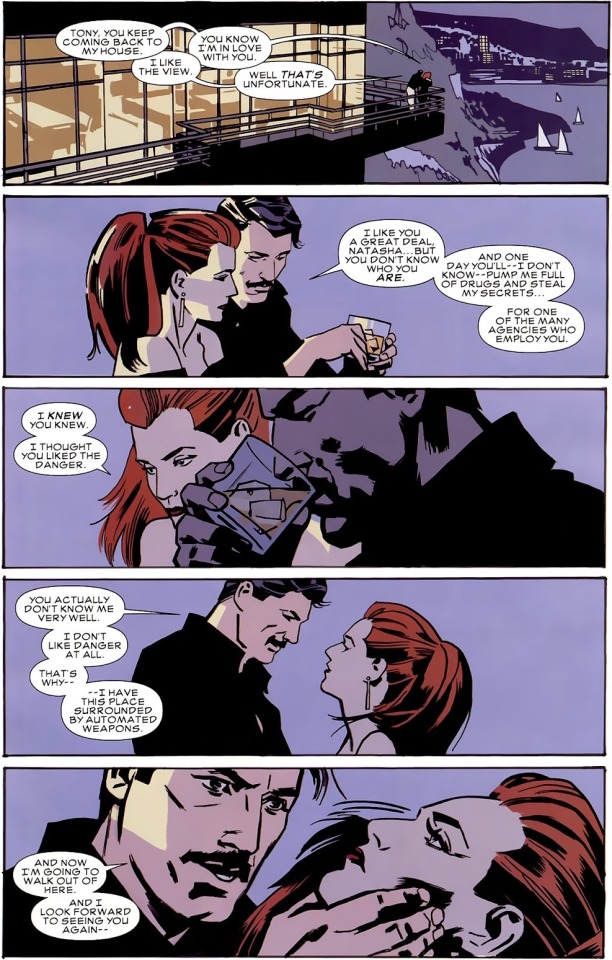

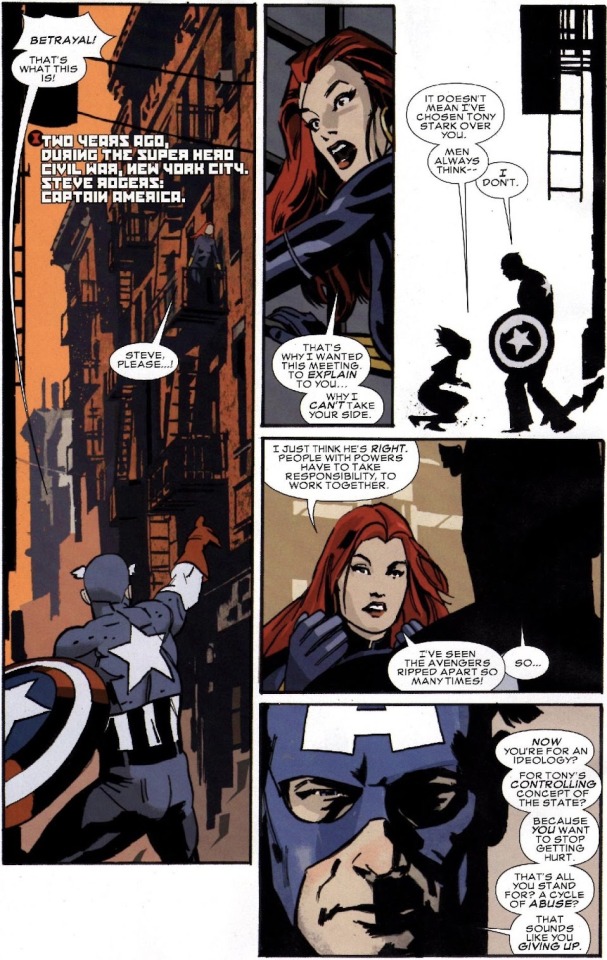
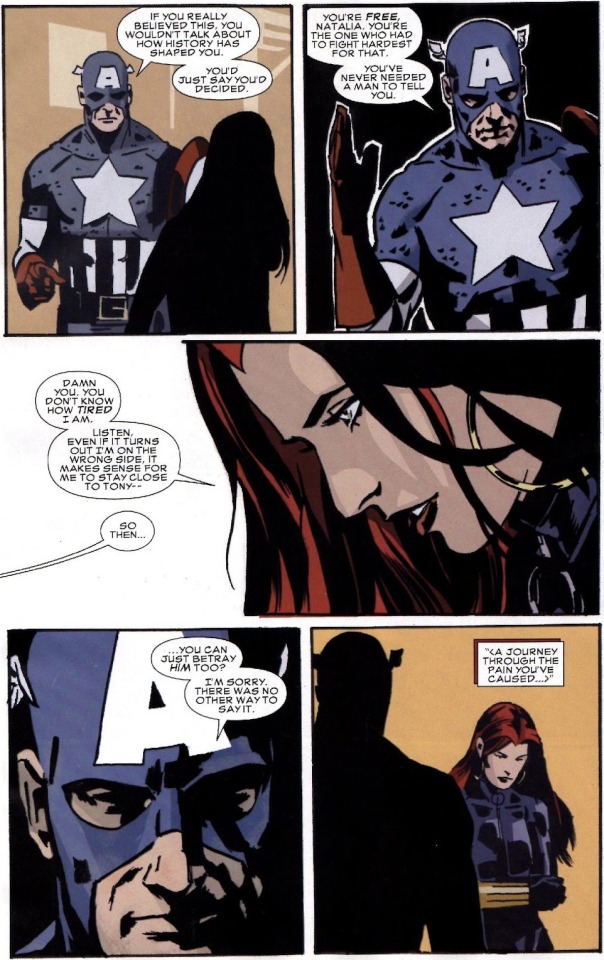
Black Widow: Deadly Origin (2010) #2 and #4
#I also really liked this aspect of Natasha’s characterization#her struggling with how she relates to and uses men#the contrast between the flatness when Tony’s no longer playing her game#and when she’s working Clint#compared to the intensity in her conversation with Steve who she has an actual real relationship with that’s not at all based in attraction#but the fact that she’s still that willing to betray people#well… men#also the fact that this book worked through the history of the various characters that Natasha has been closely associated with#meaning the men that she’s been involved with#her relationships with women were limited to talking about Bobbi when Bobbi was unconscious and one panel with Yelena#it’s said in Captain America (2005) that Natasha really respects Sharon Carter#but I don’t know how much they’ve actually been depicted together#my Natasha readings have been really patchy#so I don’t know to what extent she’s been written as having actual fleshed out relationships with other women throughout her history#also I will say that I was surprised that there wasn’t a flashback scene recontextualizing Natasha’s history with Nick Fury#that felt conspicuous when their relationship came across as significant in the Natasha comics I have read#marvel#natasha romanoff#steve rogers#my posts#comic panels
6 notes
·
View notes
Text

OWEN MERCER READING GUIDE
Owen Mercer is the son of Digger Harkness (Captain Boomerang) and Meloni Thawne, having been conceived while Digger was trapped in the 30th century. Owen never got to learn Meloni was his mother, and it was never revealed how Owen was sent back to the 21st century.
Owen longed to meet his birth father, but when Digger was killed after a mission to assasinate Tim Drake's father Jack Drake, Owen took the mantle of Captain Boomerang, Jr.
Owen's time in comics was short, but eventful. He was a member of the Rogues, Suicide Squad, SSoSV and Outsiders; before he was killed in Blackest Night.
Owen Mercer is brothers with Bart Allen aka Impulse.
This list contains all the comics Owen had been in, in chronological order.
Happy reading!
Identity Crisis (2004) #3-6
The Flash #217, #219 (cameo)
The Flash (1987) Extra 1/2 (Takes place between #219 and #220)
The Flash (1987) #220-223, #225
Outsiders (2003) #32-38
Robin (1993) #152
Outsiders (2003) #39
Robin (1993) #153
Supergirl (2005) #9
Outsiders (2003) #40
Supergirl (2005) #10
Outsiders (2003) #41-42
Supergirl (2005) #11-12
Outsiders (2003) #43
Supergirl (2005) #13
Outsiders (2003) #44
Supergirl (2005) #14-15
Outsiders (2003) #46
Outsiders (2003) Annual 1
Supergirl (2005) #16
Checkmate (2006) #13
Outsiders (2003) #47
Checkmate (2006) #14
Supergirl (2005) #19
Outsiders (2003) #48
Checkmate (2006) #15
Outsiders (2003) #49-50
Outsiders: Five of a Kind - Nightwing/Boomerang (2007)
Suicide Squad (2007) #3 (cameo), #4-8
Manhunter (2004) #34 (cameos in #33, #35-36)
DC Universe Holiday Special (2009)
Blackest Night: The Flash (2009) #1-3
CAMEO APPEARANCES
This is the list of comic book issues where Owen had cameo appearances. He had none to few lines in these issues and didn't have any impact on the events occured in them. They are also listed in chronological order.
52 (2006) #24, #33-34, #45
Countdown (2007) #39
All Flash (2007) In this one-shot, Owen captures Heat-Wave and Weather Wizard, two of the Rogues responsible for Bart's death.
Justice League of America (2006) #15, #17-18.
Robin (1993) #165 (Flashback only)
Catwoman (2002) #74
Salvation Run (2007) #2
Gotham Underground (2007) #1, #3, #6
Blackest Night (2009) #1
#owen mercer#captain boomerang#dcedit#comicedit#dc#dc comics#flashfam#flash rogues#the rogues#captain boomerang jr#suicide squad#outsiders#dcmultiverse#dcfilmblr#dcfilms#dailydccomics#digger harkness#meloni thawne#bart allen#reading guide#reading list#p: owen mercer#*
204 notes
·
View notes
Note
Where do you read ur old timey Bucky comics, and more importantly which ones are you reading?
when i'm feeling like taking my internet safety into my own hands like a small child carrying a giant pot of boiling water precariously across the kitchen i use readcomiconline (i am always doing this) with my best friend ublock origin :) otherwise i use getcomics, which seems fine, idk
for OLD TIMEY bucky i have reread the tales of suspense issues where they have ww2 era steve & bucky flashback adventures (i was there for tony the first time around <3 theyre cute <3 the art is nice) which is issue #63-71 i think?
right now i'm reading the invaders (1975) :)
edit: is 2005 old timey. it was 20 years ago. i may pass out. i did also read THEEE winter soldier comic the bucky resurrection origin comic which is i guess just called captain america (2005) that was good it hurt me a lot emotionally :(
#though i might be BACKTRACKING because apparently Giant Size Invaders comes FIRST and you can read that FIRST. who knew. not me#i also have a friend who understands torrenting so i may ask him to help me Obtain Baby Buckies but like we'll see as we go here#i know fuck all about comics re: order of reading things so i am just kind of vibing :)#kayvswords#kayvscomics
8 notes
·
View notes
Text
AI-Less Whumptober 2023 Moodboards

Main Masterlist
AI-Less Whumptober 2023 Fic Masterlist
Thank you to @ailesswhumptober for hosting the event! All of this year's prompts can be found here.
Day 1 with Drugging - Batman Begins (2005)
Day 2 Insomnia - The Killing (2011-2014)
Day 3 Isolation - For All Mankind (2019-)
Day 4 Betrayal - One Bad Day.... (Batman x Batmom!Reader)
Day 5 Held at Gunpoint - Sympathy for the Devil (2023)
Day 6 Mind Control - Captain America: The Winter Soldier (2014)
Day 7 Flatline - The Suicide Squad (2021)
Day 8 with Alt Disowned by Family - Top Gun: Maverick (2022)
Day 9 with Presumed Dead - The Dark Knight Rises (2012)
Day 10 with Collar - Star Wars IV: Return of the Jedi (1983)
Day 11 with Paralyzed - Iron Man (2008)
Day 12 with Sacrifice - Star Trek II: The Wrath of Khan (1982)
Day 13 Alt 25 with Stalked - Friday the 13th (1980)
Day 14 Alt 29 with Prison - Daredevil (2015-2018)
Day 15 with Experimentation - Guardians of the Galaxy Vol. 3 (2023)
Day 16 with Hospital - The Last of Us (2023-)
Day 17 with Heat Stroke - Better Call Saul (2015-2022)
Day 18 with Alt 20 Mutilation - Altered Carbon (2018-2020)
Day 19 with Left Behind - The Martian (2015)
Day 20 with Alt 13 Grief - The Mist (2007)
Day 21 with Near Death Experience - Jurassic Park (1993)
Day 22 with Alt 2 Gunshot Wound - Killjoys (2015-2019)
Day 23 with Forced to Watch - iZombie (2015-2019)
Day 24 with Failed Escape - The Strangers: Prey at Night (2018)
Day 25 with Flashback - Bad Times at the El Royale (2018)
Day 26 with Magical Injury - Train to Busan (2016)
Day 27 with Alt 3 Separated from Loved One - Warehouse 13 (2009-2014)
Day 28 with Alt 30 Silent Treatment - A Quiet Place (2018)
Day 29 with Forced to Choose - Titanic (1997)
Day 30 with Possession - Legion (2017-2019)
Day 31 with Alt 9 Forced Feeding - Fright Night (2011)
#ailesswhumptober2023#whumptober#whumptober 2023#moodboard#masterlist#batman#dc#marvel#avengers#joel kinnaman#lewis pullman#aaron ashmore#christian bale#whump#angst
11 notes
·
View notes
Text

((In reference to this story, for some reason.))
This...this pisses me off. I don’t *think* you’re trolling, so I’m choosing to give you the benefit of the doubt and assume you don’t know how rude you’re being.
(I don’t want anyone else to go and harass this person, either.)
First off: my inbox is temporarily closed for a reason. I was feeling burnt out on answering questions. I worked my ass off for that story. I took AGES writing all 6000+ words of it. I was excited when I got a couple replies for it...only to be met with someone insulting my ship and making ignorant claims about characters’ ages.
The reply section is for sharing your thoughts on that post. It’s not there so you can make off-topic criticisms and accusations. I didn’t put in all that effort for free in my spare time in the hopes that random people would waltz in and insult the entire purpose of this blog. You have your own blog for that. The reply section is NOT an inbox.
Now, the age thing. Short answer: No.
Long answer under the cut, because although it took longer than I expected to get my first instance of Shadamy Age Discourse, I want to have all of this in one place in case I get any more of it.
I don’t know which bootleg wiki that number was pulled from, but there has never been one shred of evidence in canon that refers to Shadow as 18. Not a single one. Whoever told you that is either accidentally spreading misinformation or flat-out lying. Always check the source if you’re pulling something from a wiki.
As a side note: some people are calling Shadow 17 right now because when you google “Shadow the hedgehog age,” you get this...

....but that isn’t Shadow’s age, either. It’s the age of the 2005 game named after him. You can see the ages of some other games and the synopsis of ShTH right underneath. People said he was 15 two years ago because of this. I wish Google would format it differently. It gets worse every year. This is a good example of why telling a legitimately curious person to “just google it” is not always a good idea.
As for canon analysis, traditional numbers do not work for Shadow’s age. The official word is that he is ageless. His timeline goes like this:
1. Created 50 years before the events of SA2 by Gerald Robotnik. Gerald is able to enlist the help of Black Doom by promising he’ll deliver him the seven Chaos Emeralds 50 years in the future.
2. Maria seals him in a stasis pod and sends him to Earth, where he’s released 50 years later by Eggman.
3. Black Doom arrives on schedule and demands the Emeralds.
This means Shadow was alive for less than a year on the ARK, yet he was already perfectly capable of having deep thoughts and carrying on full conversations with Maria, as shown in flashbacks. Whether it’s because he’s the ultimate life form or it’s a side-effect of his Black Arms DNA, his chronological age simply doesn’t operate the same way other Mobians’ do. He wasn’t affected by his time in stasis, either; he behaved as if he’d lost Maria yesterday. If he’d been conscious and aging all that time, his psyche would have been broken beyond repair. It’s an Aang/Captain America kind of situation.
So Shadow isn’t a middle-aged man. He’s not an infant. He’s not 17. And he’s definitely not 18. He is canonically ageless.
I personally care more about mental maturity with regards to this. It’s subjective, of course, but my opinion is that he’s mentally about 15, for these reasons:
- Sonic, who’s supposed to be his equal/foil, is 15. Sonic’s rivals are also consistently very close to him in age: Knuckles is 16, Jet is 14, Silver is 14, Blaze is 14, etc. I don’t think Shadow is presented as more mature than Sonic is, either. They typically have valid but opposing viewpoints on how to deal with problems.
- Shadow is often naive and easily manipulated (Gerald in SA2, Black Doom in ShTH, even Eggman if you count Sonic Boom).
- In his self-titled game, he displays various immature behaviors like having mood swings and constantly peppering his speech with minor curses like “damn” and “hell,” as if he’s a typical 14-year-old trying to sound cool and mature on his first day of high school.
Shadamy is fine. A three-year age difference is perfectly normal for adults. Anyone who actually reads that story you replied to will know it takes place many years after current canon. Just like almost all of my headcanons, it focuses on the potential future they have together. They don’t need a relationship right now.
And you know what’s even more important than all of that? Sega recently removed the ages from the characters’ bios on their website. Every single one. This could mean one of two things:
1. Frontiers takes place after a time skip. Sonic’s voice is noticeably deeper, and Ian Flynn seems to know something we don’t:
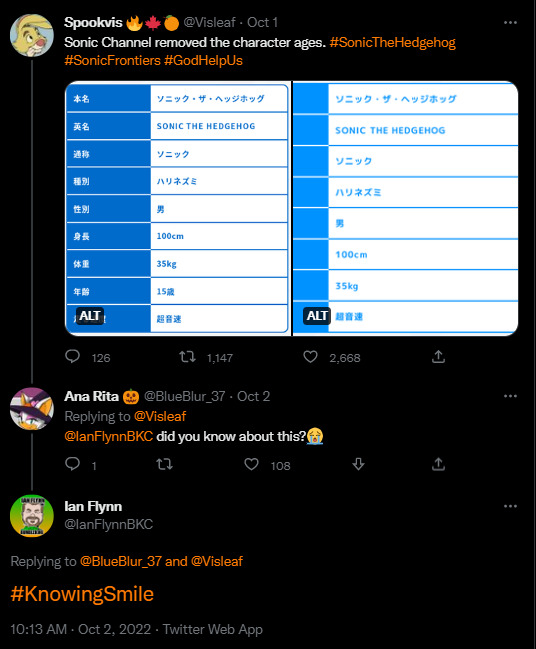
[Source]
Maybe all the ages will be retconned. It wouldn’t be the first time. Amy was originally 8. Knuckles was originally 15. Rouge was 17 in Sonic Heroes. I assume Sega then realized their “sexy” femme fatale character was a minor, so they panicked and hastily bumped her up to 18, something that will never not be funny to me.
OR...
2. They could be ditching canon ages altogether, which I wouldn’t be entirely opposed to. Some fans feel it was a mistake to include them in the first place, and when you get right down to it, most of them don’t make sense.
- Sonic had a birthday, but his age didn’t change.
- There are basically no adults. Rouge is only 18, but she’s somehow a secret agent who also runs a casino. You have to be 20 to drink, gamble, and enter a casino in Japan! She has to break the law every time she goes in there!
- Jet’s 14, but he leads the Babylon Rogues even though Wave is apparently 18 and Storm is 19.
- Tails is a homeowner. He is eight. Charmy is a professional detective. He is five. These are hilariously nonsensical.
Soooo...yeah. Shadow’s an ageless enigma in a franchise where exact age doesn’t seem to mean anything. You can personally think of him as being one age or another in terms of vague maturity, but you shouldn’t go around nagging real, hardworking people about made-up numbers.
If you’re actually interested in Shadamy, you can read some of my stuff. Try this cute headcanon. Or this AU. Or this little friendship ficlet.
If you don’t like Shadamy and you’re only here to talk down about the ship and my work, then go literally anywhere else on the internet. Up to you.
#not a headcanon#discourse#handsoffmychillidog#am i overreacting? no#keep in mind that everyone who creates art on the internet is. y'know. a real person#who works hard and puts a piece of themself in every work they create#hell#just writing this post took a few hours#thanks to everyone who wrote kind words tho#i did feel very appreciated#i just feel...a certain way about this kind of thing
50 notes
·
View notes
Photo
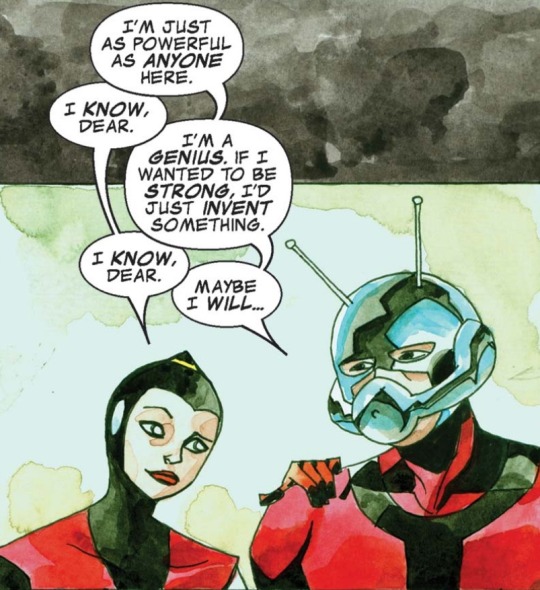

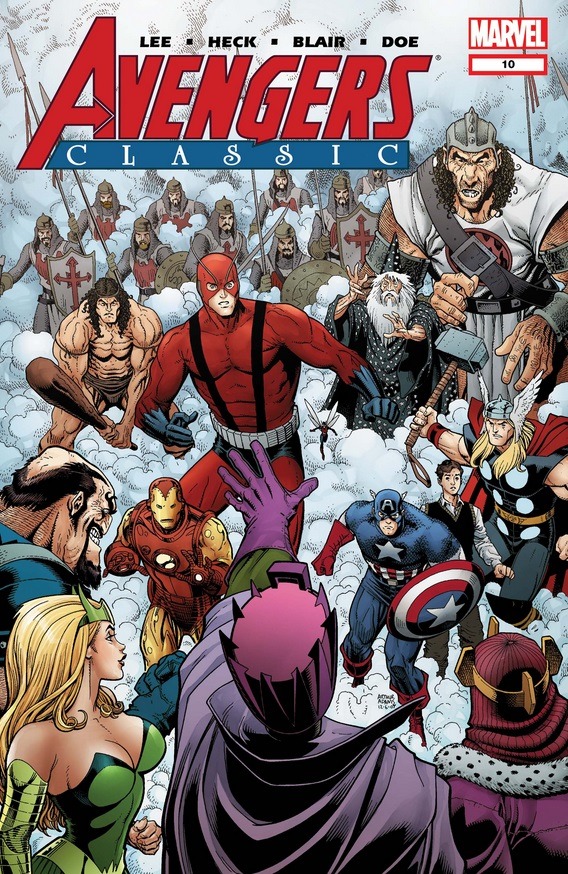
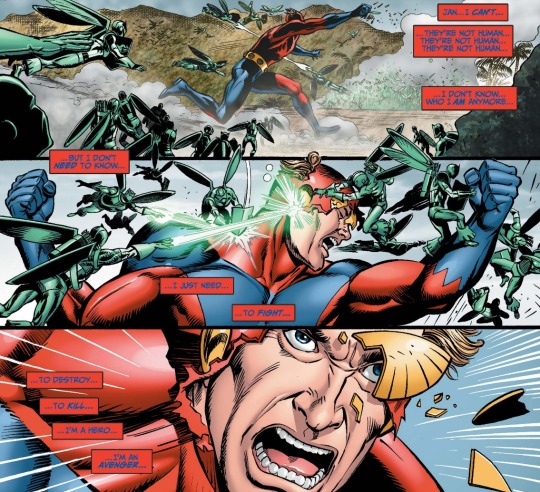

Into the Anthill pt 38 - Flashbacks Only (The Skrull Years)
So Hank got replaced by a skrull and missed about 3 years of Marvel’s publication history. Happens to the best of us I guess. In that timeframe the skrull named Criti Noll impersonated Hank for about 90 comic issues from House of M to Civil War to the start of Secret Invasion. So, the only comics I can genuinely count as Hank’s appearances here are the flashback and retcon stories he appeared in.
It’s a good thing he was a founding Avenger or there wouldn’t have been shit to cover here.
🐜🐜🐜
Marvel Monsters: Monsters on the Prowl
In this flashback story set before Hank ever became Goliath, Mole Man and The Collector came into competition over how many giant monsters they controlled. Mole Man released several of his into NYC to wreak havoc to prove that his monsters were better. Thing and Hulk were joined by Giant-Man and Beast to fight them.
Avengers: Earth’s Mightiest Heroes II vol 1 #1-8
With the recent addition of Vision to the Avengers’ roster, the founding members got together for a meeting. Goliath, now serving as chairman, had an uphill battle with the National Security Council ahead of him now that Captain America was off the team. S.H.I.E.L.D. took Vision into custody to interrogate him soon after, partly to vet his intentions and partly to make sure he had nothing to do with their recent Super Adaptoid intel. Apparently A.I.M. had planned to mass produce them but lost control and had their island base overrun by them. Hank led the team to the island to handle the Adaptoid threat and destroyed dozens of them on his own as Goliath while the rest of the team shut down the production line. The original Super Adaptoid escaped without a trace and Hank began to suffer nightmares about the battle. He awoke in a cold sweat and headed to his lab, where he brushed everything off of one of his tables in a rage. The gaseous reaction from the chemicals he’d knocked over caused the temporary psychosis that led him to becoming Yellowjacket.
This retconned version of the Yellojacket story asserts that everyone knew he was Hank the whole time but played along because he didn’t seem to know it himself. They worried that trying to snap him out of this by force could break him entirely, so they allowed the farce to play out to its logical conclusion. Jan, asserting that she was the only one who knew what was best for him, arranged their wedding as fast as she could and even had a S.H.I.E.L.D. agent stationed as the minister. Amid rising concerns about his mental health Hank stepped down as Avengers chairman after the wedding.
Avengers Classic vol 1 #1-3
At the second monthly meeting of the original Avengers Jan diffused a brewing fight between Hulk and Thor by calling both of them pretty. Iron Man tried to start the meeting by clarifying that he was their leader, but Hulk, Thor, and Ant-Man each argued that they were more qualified for the role. Thor suggested arm wrestling for it, but Wasp had a better idea: make her the official chairman on the charter because “it won’t count since she’s a girl,” leaving their masculinity intact. Some time later after Hulk quit the team, Iron Man and Giant-Man had a practice battle against each other to see if the Iron Man mk 3 armor could keep up with Hank’s newly increased size and strength. On the ride home Hank confided that he didn’t think he was strong enough for this line of work and admitted that he’d already figured out Iron Man’s secret identity.
Minor/Cameo appearances from this period:
Marvel Monsters: From the Files of Ulysses Bloodstone & the Monster Hunters
Avengers Classic vol 1 #6, 10-12
Criti Noll’s appearances from this period:
House of M vol 1 #1-2
Secrets of the House of M vol 1 #1
Iron Man: House of M vol 1 #1-3
New Thunderbolts vol 1 #13-14
Marvel Holiday Special 2005
Beyond! Vol 1 #1-6
Friendly Neighborhood Spider-Man vol 1 #2, 4, 24
The Thing vol 1 #8
Civil War vol 1 #1-4, 6-7
Wolverine vol 3 #42
She-Hulk vol 2 #7, 15
New Avengers vol 1 #21-24
Amazing Spider-Man vol 1 #533-534
Thunderbolts vol 2 #103-105, 107-108, 116
Civil War: Choosing Sides vol 1 #1
Civil War: Frontline vol 1 #6, 9-11
Fantastic Four vol 3 #539, 543, 547-549, 556-557, 559
Civil War: The Return vol 1 #1
Fallen Son: The Death of Captain America vol 1 #1, 5
Wonder Man vol 3 #5
Mighty Avengers vol 1 #3-6, 8
Irredeemable Ant-Man vol 1 #1, 3-5, 12
X-Men vol 2 #200
Eternals vol 2 #5-6
Avengers: The Initiative vol 1 #1-9, 12-13
New Warriors vol 3 #4
World War Hulk: Aftersmash - Damage Control vol 1 #1-2
Avengers: The Initiative Annual vol 1 #1
Adam: Legend of the Blue Marvel vol 1 # 1-2, 4-5
3 notes
·
View notes
Photo
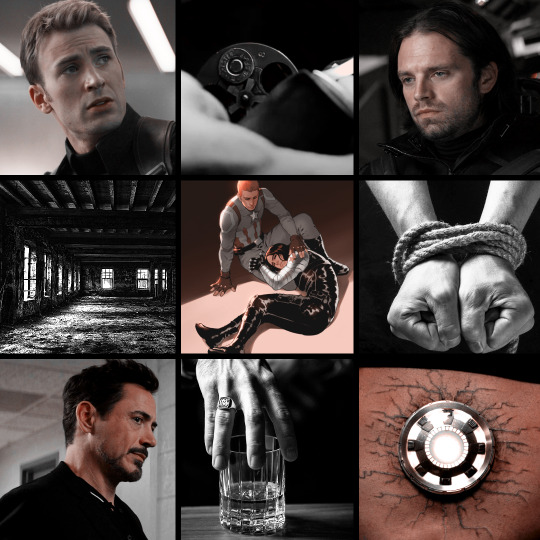
One Out Of Six (AO3)
Part of the Steve-Tony-Bucky-Bingo @stb-bingo
Prompt: Evil!Tony
Archive Warnings: Graphic Depictions of Violence, Major Character Death
Summary: When Steve receives a distress text from Bucky, he does not hesitate to help his boyfriend.
His jump to action is leading both himself and Bucky straight into a well-designed trap because in the abandoned industrial building Tony Stark, SHIELD's weapons supplier, is waiting for them and he has brought a brand new model with him: a revolver with only one bullet.
"Ever heard of Russian roulette?"
Words: 8919
Rating: Explicit
Shipping: Steve Rogers / Bucky Barnes
Status: Finished
Tags: Blood, Violence, Torture, Established Relationship, PTSD, Russian Roulette, Evil Tony Stark, trap, Guns, Weapons, use of weapons, Character Death, Not Canon Compliant, Graphic Violence, Suicide, Electric shocks, hold captive, Palladium Poisoning, Mental Breakdown, Kidnapping, Hurt/Comfort, Emotional Hurt/Comfort, Flashbacks, Emotional Manipulation, not too graphic but still there, Howard Stark's A+ Parenting, Revenge, Dark, Darkfic, Villain Tony Stark
Click here to read it on ao3 and share if you liked it :)
————————————–
Image Credits:
@rebelflet on tumblr
unknown on pikist
Macho Moda on pinterest
Kiss Kiss Bang Bang (2005)
Iron Man 2 (2010)
Captain America: Civil War (2016)
Captain America: The Winter Soldier (2014)
#marvel#mcu#mcu fic#marvel fic#userbecci fanfiction#fanfiction#ao3#archive of our own#fanfic author#Author#myfanfiction#fanfic#steve rogers#tony stark#bucky barnes#stucky#evil tony#moodboard#cw gun#cw blood#cw violence#russian roulette#prompt#stb bingo#oneshot#cw character death#hurt / comfort#angst#my fic
6 notes
·
View notes
Text
Cobra Kai and the Debate Around Cultural Appropriation
https://ift.tt/eA8V8J
This article contains Cobra Kai spoilers.
Why aren’t there more Asians in Cobra Kai?
Since Cobra Kai first premiered on YouTube, The Los Angeles Times, Vanity Fair, and other publications have called out the series for its lack of Asianness. The series also scored poorly on UCLA’s 2020 Hollywood Diversity Report. Miguel (Xolo Maridueña) and Carmen (Vanessa Rubio) are the only non-white main characters. This was exacerbated when the recently-released season 3 excluded Aisha (Nichole Brown), a major character of color who was a fan favorite.
Granted, Cobra Kai does have a few non-white actors in reccurring roles. They just aren’t leads. Nate Oh plays Nathaniel, but he is a minor character with minimal development. Kyler (Joe Seo) was the first bully to appear in Cobra Kai constantly harassing Miguel. To their credit, the writers made him a wrestler instead of a stereotypical martial artist, just because he’s Asian. Cobra Kai has revealed character backstories for nearly all the show’s bullies, including Kreese (Martin Kove), but not Kyler. He remains a secondary character, but has potential to emerge as a major villain next season.
Season 3 also enjoyed some added Asian representation during Daniel’s trip to Okinawa with heartfelt cameos from Tamlyn Tomita (Kumiko) and Yuji Okumoto (Chozen) from The Karate Kid Part II. While both characters figure largely in the canon, their Cobra Kai appearance was too limited to be as Asian inclusions to the main cast. Perhaps they’ll return in season 4. Maybe Johnny (William Zabka) needs to learn Chozen’s pressure point technique too. (I would love to see Johnny in Okinawa.)
This is all to say that Cobra Kai is not as diverse or Asian-centric as one might expect a property about martial arts to be. But that just makes it the latest in a long line of Karate Kid properties that has had to grapple with the reality of how karate operates in a globalized world.
In some ways, The Karate Kid was groundbreaking for Asian representation when it premiered in 1984. Daniel’s (Ralph Macchio) crane kick inevitably degraded into a mocking anti-Asian gesture. The pose is iconic, but mostly as ridicule. Even Will Smith took a poke at it when Morita made a guest appearance on The Fresh Prince of Bel-Air. And yet, Mr. Miyagi’s (Pat Morita) remarkable backstory in the film brought attention to the plight of Japanese Americans like never before.
In Miyagi’s poignant drunken scene, we discover that he was a veteran of the 100th/442nd Infantry Battalion (a.k.a. the ‘Purple Heart’ Battalion) and his wife died during childbirth in a WWII internment camp. The scene was almost cut because the filmmakers felt the tangent interrupted the momentum of the action. In retrospect, it was likely that this very scene sealed Morita’s Oscar nomination. Manned completely by Japanese Americans, the 100th/442nd was the most decorated unit for its size and service in U.S. history.
Japan was the enemy, so the Battalion was constantly confronted by racism from surrounding ranks. The Army didn’t quite know what to do with them. They were sent on suicide missions in Europe, but they prevailed and kept coming back for more. They were awarded 18,143 individual decorations including 52 Distinguished Crosses and 21 Congressional Medals of Honor. The Medal of Honor is America’s highest award for combat valor. Miyagi has one. Recognizing the Purple Heart Battalion gave The Karate Kid a lot of soul, but Miyagi’s medal was historically awkward. The real story exposes deeper racial discrimination.
The Next Karate Kid begins with Miyagi attending a 442nd commendation. In a respectful cameo, appearing as the Senator at that event was Daniel Inouye, an actual veteran of the 442nd who lost his arm in combat. He was the first Japanese American to serve in the House and Senate, and was a recipient of the Medal of Honor. However, The Next Karate Kid came out in 1994, six years before he received it. Twenty of the Medals of Honor that 100th/442nd vets received were upgrades awarded in 2000 after Congress rectified the oversight. The only one prior to that was given to Pfc. Sadao Munemori posthumously. He gave his life jumping on a grenade to save his comrades. When Daniel met Miyagi, no living Asian vets had a Medal of Honor.
On a personal note, my grandfather was Captain Taro Suzuki of the 100th Battalion. Like so many of his comrades, he was wounded in action. His right hand was permanently crippled, and he still had so much shrapnel in his body that he couldn’t pass through a metal detector. I inherited his Purple Heart which I cherish like the LaRussos treasure Miyagi’s medal. I heard his war stories growing up. The Karate Kid was the first time I saw his battalion represented in a movie. Miyagi’s drunken scene is still intensely moving and personal for me.
Morita died in 2005 so Miyagi only appears in Cobra Kai flashbacks culled from the original movies. Although the series goes to great lengths to honor him, the lack of any Asian leads does give credence to those accusations of cultural appropriation and whitewashing. The thing is, much of the martial arts scene in the Western world has already been, for lack of a better term, whitewashed. And one character’s journey (and the real life figure he’s based on), helps illustrate martial arts’ approach to worldwide growth.
In Cobra Kai season 3, Young Kreese’s journey mirrors the real-life experience of the action choreographer of the original films, Master Pat E. Johnson. Kreese learned martial arts from his Caucasian commander, Captain Turner (Terry Serpico), who learned it while serving in Korea from Master Kim Sun-Yung. It was actually Korean Tang Soo Do, not Karate. Johnson learned Tang Soo Do from Master Kang Lo Hee while stationed as a U.S. Army chaplain in Korea. This is how Tang Soo Do spread westward. Many of the leading American martial arts proponents are not Asian.
Today, martial arts belong to the world. For generations, Asian traditional martial arts have striven to propagate themselves globally. Judo and Taekwondo have become Olympic events and Karate was going to be added in the 2020 Tokyo Olympics. It’s still on track when the games are rescheduled this summer. International organizations are found in every major martial arts style now and they are continuing to spread. So, it’s not entirely fair to begrudge the diaspora’s non-inclusivity.
While The Karate Kid brought martial arts to the San Fernando Valley, other films and shows have spread the martial diaspora globally. The Blaxploitation genre glorified martial arts with its own unique take on the culture. Netflix’s Seis Manos is a Kung Fu based adult animated series set in Mexico. Although it does have a leading Asian role in Chiu (Vic Chao), is this cultural appropriation? Indian movie stars like Tiger Shroff and Akshay Kumar have brought martial arts to Bollywood in force with films like Commando, Baaghi, and Khiladi. That’s not Asian cultural appropriation, even though India is a different region of Asia where we don’t typically associate martial arts.
Nevertheless, the international spread of Asian martial arts does not give filmmakers carte blanche to deny whitewashing and cultural appropriation. We must not go back to the days of Remo Williams: The Adventure Begins where Joel Grey played Chuin with slant eye makeup.
Whether Cobra Kai culturally appropriates Asian culture or not, it can certainly increase its diversity. The setting, West Valley High School, is attended by students from Encino and Reseda. While Encino is over 80% white, Reseda is over 50% Hispanic and over 11% Asian. Statistically, the inclusion of Miguel and Carmen isn’t enough. The Karate Kid franchise was pivotal for representation. Conversations about appropriation and whitewashing aside, Cobra Kai can at least honor the franchise’s tradition and increase its diversity next season.
cnx.cmd.push(function() { cnx({ playerId: "106e33c0-3911-473c-b599-b1426db57530", }).render("0270c398a82f44f49c23c16122516796"); });
Cobra Kai season 3 is available to stream on Netflix now.
The post Cobra Kai and the Debate Around Cultural Appropriation appeared first on Den of Geek.
from Den of Geek https://ift.tt/2M2KULR
6 notes
·
View notes
Note
Hi! I've been thinking a lot about this and was curious about your opinion- I've seen people online be critical of getting another fantastic four origin story potentially in the movies, similar to how people didn't want another 'uncle Ben sob story' for spidey, in the event of another FF movie would you want to see their origin explored again or would you prefer the story beginning after the fact? Would it make a big difference w their characters like not having uncle Ben to reference did?
So I’ve got a couple of different thoughts on this, but the biggest one is that we need origin stories in our superhero comics and in our adaptations because without them, we are missing a crucial building block in the foundation of characterization. Superman and the destruction of Krypton and his arrival on earth as a baby. Batman and the death of his parents. Spider-Man and the spider’s bite, the decision not to stop the burglar, and the subsequent death of Uncle Ben. I don’t think a lot of people who argue against even referencing the death of Uncle Ben realize the narrative weight involved here, or maybe the absolutely ordinariness of the scenario makes people uncomfortable: there’s no planet to be destroyed, and the fate of Batman’s parents have a certain dramatic quality about it, with the image of the wealthy Waynes, of Martha’s pearls, and young Bruce being made to witness these acts. Peter never sees Uncle Ben get killed. He’s shot by an ordinary thug. This action comes about through Peter’s inaction. It’s not the kind of crime that would make the front page of a paper if not for Spider-Man’s involvement in the capture of the criminal. It is actually, when you look at it, a painfully average sort of crime: an old man shot by another man with a gun during a bungled home invasion. And I don’t know if the aversion to seeing it again comes from a lack of empathy -- the audience refuses to feel for Peter because of the lack of superhero flair contained within the scene -- or from an abundance of this -- they “don’t want to see another Uncle Ben sob fest” because, in that there’s no superhero drama in it, it’s too easy to imagine the same sort of thing happening to someone in your life. But the thing that makes Spider-Man extraordinary has always been taking the ordinary and applying that to a superhero. It’s why he worries about bills. And it’s why his uncle dies in a way that has no flair to it. Peter’s not the lone survivor of an alien planet. He’s not the scion of a made up city’s elite and wealthy family. He’s an ordinary guy from a real city, and his uncle gets killed and that’s it: it’s mundane and terrible and like many people who experience a loss, he rationalizes that if he had taken different actions he could have prevented it, imposing his own responsibility on an event he couldn’t have foreseen. Beyond cementing responsibility in Peter and painting him with a certain down to Earth brush, though, Ben’s death serves another narrative function: without it, we don’t know how Peter functions as a crimefighter. Most Peters, including and originated with 616 Peter, when left to his own devices and without supervillain intervention, target street crime: muggings, drug dealers, assaults in the night, gun crime, illegal weapons. He also doesn’t use guns. Noir Peter, on the other hand, has a Ben who wasn’t shot as a means of murder, and that shows: he believes the mob murdered his uncle, so he cracks down on organized crime. His Ben wasn’t shot, so he has no problem using guns. You don’t have to spend the 40 minutes The Amazing Spider-Man (2012) took to set up Ben’s death, but without even referencing it or letting us know how Peter feels in response to it, there’s something vitally missing from the story and from our understanding of Peter as a character. Origin stories are important because they let us know what set the characters on this path, and people who are impatient with them need to consider that even if they know the story, a new movie will always be someone’s introduction to a character, and those new fans deserve to know that character’s origin story to its fullest. This might not be your first time watching an origin story, but it will definitely be somebody else’s. This isn’t to say the origin always has to be done in full, but I do think it has to be respected within a new piece, and it’s weird to me that some characters get this respect and others don’t.
On the other hand, we have to look at the Fantastic Four’s original origin and its execution within Fantastic Four #1. This is one of those origins that we have to adapt for the times -- and obviously comics have had to do this too as the sliding timescale moves along -- because there’s a big problem in that we can’t have the Fantastic Four steal a rocket because they want to beat to Russians to space. Fantastic Four itself is a little weird about the origin story: Fantastic Four #1 doesn’t open with it itself. Instead we’re introduced to a faceless “strange man” who monologues to himself that he’d hoped he’d never have to fire the signal to summon the mysterious Fantastic Four and prays it will be the last time. We’re then introduced to three individuals who display strange powers -- a woman running out on a society friend by turning invisible; a huge man who is having trouble being fitted for new clothes reveals a monstrous form; a teenager tinkering with an engine bursts into flame. We’re introduced to the Fantastic Four in their already powered state before a flashback takes us through how the cosmic rays transformed them, meeting them in their transformed state before we learn what it was exactly that transformed them. So in a way I do think you could make an argument that they’re suited for fast-forwarding through the origin story and perhaps revisiting it later, but there’s a few things about the origin story that inform the Fantastic Four in very important ways. First of all, the audience needs to understand that these are people who thought of and followed through with a plan to steal a space mission. Making it a planned space mission they’re all legally along for the ride on ala Fantastic Four 2005 automatically undermines the fact that the Fantastic Four are hugely independent free thinkers who don’t let little things like “canceled missions” keep them from breaking into government property and taking a couple billion dollars for a joyride just to prove a point. They’re rule breakers -- more than that, they invent new rules. The audience has to realize that these are people who will defy the government in favor of breaking ground and the discovering the new. Fant4stic (2015) did this better -- Reed, Ben, Doom, and Johnny very much do take an unsanctioned trip to another dimension just so they can be the first -- but it’s very Ultimate-inspired as origin retellings go, and I don’t like that Doom took Sue’s place in the original government property stealing lineup. Second, we need the origin to make it clear that Reed feels very guilty about the fact that the shielding wasn’t good enough and that he is responsible for the transformation of the three people he loved the most.

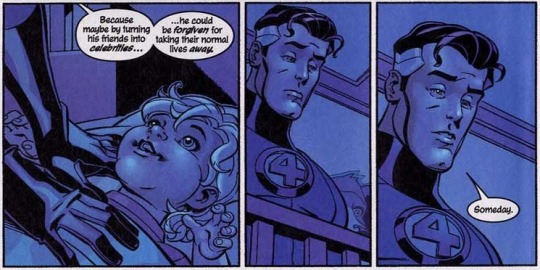
(Fantastic Four v3 #60)
We also need the origin story for the Ben angle. Now this is a thing I love about Fant4stic (I know, I know, but you all should know who I am -- a Fant4stic apologist -- at this point), and I think it’s actually a good thing about the fact that, going in, much of the viewing audience might already know the origin story: you can use that knowledge of the origin story to build up a lot of tension. If we know something has to happen within the story -- the transformation of the Fantastic Four, the spider biting Peter Parker -- then we have to be waiting for it. The shotgun, so to speak, is on the wall. The first Captain America film did this: obviously, I as a person who was familiar with Bucky Barnes knew he had to “die”, and I remember being on the edge of my seat waiting for it. Fant4stic does this with Ben: we know what happens to Ben, especially, out of all of the Fantastic Four. We know how monstrous his transformation is. We know he can’t turn back. And we know how that makes him feel. So we’re waiting for this horrible thing to happen to him and I don’t think that has to be a drudge -- I think it can be really quite exciting. It’s all in how confidently the creators embrace their source material and their skill as storytellers.
If there’s one thing I think fans should be advocating being left out of a brand new Fantastic Four movie, it’s Doom. The Doom Trap is a huge Fantastic Four adaptation problem; they need to stop writing him into the origin story alongside them when it erases his own origin, and makes a film that has to introduce four main characters all with complex relationships with each other too crowded when they’re trying to do the Ultimate Big Bad of the Fantastic Four right off the bat. Personally, I’d kill to do another little origin -- the first bad guy the Fantastic Four ever faced -- and have a new film feature the Mole Man as the main antagonist.
56 notes
·
View notes
Note
What can you tell ne about Reed and Ben’s past military service?
I can tell you plenty! Ben and Reed were originally both WWII veterans – war heroes, actually. Ben served in the Pacific Theater as a fighter pilot with the Marines – and he was a very famous war hero. The work Reed did, on the other hand, was just as dangerous – if not more so – but he didn’t get much public recognition for it. He served as a spy for the O.S.S., an early WWII version of the CIA, working behind enemy lines with the Italian underground to help free prisoners from the Nazis. Their military service is first established in Fantastic Four v1 #11:

There are a few other references to their service during the Second World War that I can recall – there’s one in Marvel Two-In-One v1 #64, where Ben mentions that he and Reed served together on at least one mission that seems to have gone very wrong:
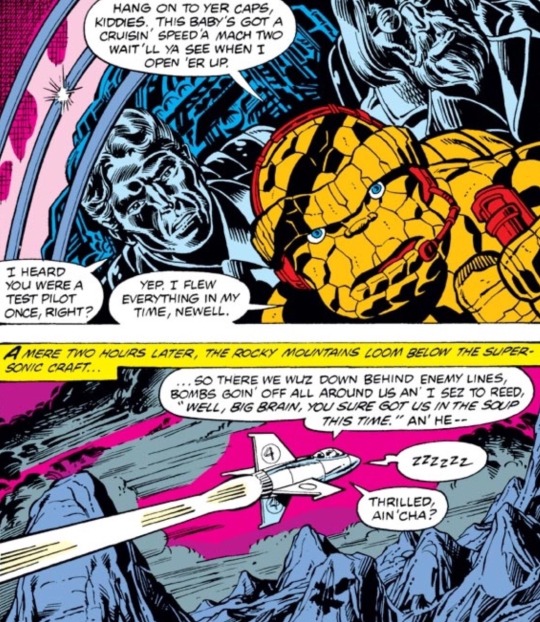
And later in Marvel Two-In-One v1 #77, we see flashbacks to a mission Ben went on with Nick Fury and his Howling Commandos. Ben is VERY unhappy that Fury has him flying a transport plane instead of a fighter plane:




I assume this means that Ben must have served in the European Theater at least briefly. Which makes sense, and also means that Reed and Ben potentially served together for some time before eventually getting split up when Ben was reassigned to the Pacific.
We also see Fury meeting a certain Major Richards of the O.S.S. in Sergeant Fury and his Howling Commandos #3 while in Italy, and he mostly seems very impressed by Reed and his bravery:



This is actually the first time they met – so Fury has known Reed and Ben since before they became superheroes. Also interesting is the fact that both Ben and Reed made it to the rank of major at the very least, meaning that they both outrank Captain America (but are outranked by Captain Marvel/Carol, who, despite her misleading name, was a full colonel when she left the military).
Eventually, though, it stopped making sense for Reed and Ben to have served in WWII without both of them being far too old to continue being superheroes. There was a brief attempt to deage them and Sue in 1980, but it didn’t really stick. Instead, we started getting vague references to Ben having been a test pilot for the Air Force who participated in secret missions and eventually wanted to become an astronaut, while references to Reed’s military service began to fade away. 2004’s Marvel Knights 4 #4 even transferred Reed’s WWII military service to his grandfather, John Richards. The last time I can remember any writer referring to Reed’s military service happens in 1998’s Fantastic Four v3 #5, when Reed and Alyssa Moy recount their adventures just after Reed got out of the military:

Honestly, I’m fine with Reed’s military service vanishing – I don’t think it makes much sense for the most brilliant man alive to be put on active duty. He’s also been seriously deaged since Fraction’s new origin story, so there isn’t much time between his first meetings with Ben and Sue and the rocket flight. I honestly can’t tell you if it’s still canon that he served in the military — 2005′s Fantastic Four: The Wedding Special, where Reed specifically tells Sue that he’s spent all of his time in the lab and only dared venture out because of her encouragement, certainly makes it sound like it no longer is.
I think that eliminating Reed’s military service, though, makes it make far less sense that he would be the leader of the FF — it made sense for a former spy, war hero, and trained soldier to lead a team of superheroes, but it makes far less sense for a scientist with no battlefield experience. At that point, Ben and Sue would be the better options — both are trained fighters, and Reed isn’t. This is partly why I’m rooting for Sue to be the leader of the FF in the MCU — she deserves it, she’d be great at it, and I don’t think it necessarily makes sense for Reed to be in charge if he’s no longer a former spy and war hero. He can go off and handle the science in the background, while Sue leads the rest of the team.
There have been numerous more recent references to Ben’s military service, and I highly doubt whether Ben being a test pilot turned wannabe astronaut ever won’t be a part of his backstory. In 1996′s Fantastic Four v2 #1, Reed explains that Ben’s dreams of being an astronaut were dashed by mysterious, unspecified wounds during the first Iraq War.

We also have seen several flashbacks to Ben and Wolverine’s joint missions while they both were in the military. We see them meet in 1997′s Wolverine v2 #-1, where Ben is tasked with flying Logan to the U.S.


They team up for a second mission in a three-issue miniseries from 2000, Before the Fantastic Four: Ben Grimm and Logan, and they don’t particularly like each other – there are fun cameos from Tony Stark, Carol Danvers, and Natasha Romanoff in this series.


Those are all of the references to their military service that I can remember.
11 notes
·
View notes
Text
'Boys have role models, why shouldn't we?' How female superheroes like Captain Marvel are filling a void
There's a scene in the new film Captain Marvel in which the titular Captain, played by Brie Larson, is facing certain adversity. To draw strength, she experiences a flashback to all the times in her life when she was knocked down and told to quit because, well, she was just a girl.
youtube
You can also see the moment in a teaser trailer, which shows the young character getting knocked down over and over again, only to turn and give the camera that defiant superhero stare: a look that says, no matter how big the odds stacked against the character, they will overcome them. It's an image we've all seen before, but for such a cliché, it's a scene we don't see given enough to women onscreen, let alone female superheroes.
"You don't often see a movie in general with such a strong female lead, so seeing that really hit home for me," says Saara Chaudry, 14, a contributor to CBC Kids News who saw an advance screening of Captain Marvel. "It made me feel warm, knowing that women were being represented in this light, but at the same time it spoke to personal experiences that I've had. It had me on the edge of my seat really just thinking about every time that I've been knocked down."
That sentiment was certainly intentional, according to Anna Boden, who co-wrote the film with Ryan Fleck. "As she gets to know herself and embrace what makes her her, she really achieves her true power," Boden told the New York Times, of the character. "Part of that means rejecting the voices of people who tell her she's not strong enough and doesn't belong. I feel like a lot of people will be able to relate to that, particularly women."
Captain Marvel is the 21st movie in the Marvel Cinematic Universe, and yet is only the first film to be centred around a female superhero. DC Entertainment beat Marvel to the punch by two years with Wonder Woman, the Gal Gadot-starring box office and critical juggernaut that is still one of the top-grossing films to come from the DC Universe (a sequel is already slotted for 2020).
Two films in two years may not seem like a lot — it's not — but to put it into perspective, it was only in 2015 that a leaked email from Marvel chairman Isaac Perlmutter revealed his distaste for female superhero films, citing Supergirl (1984), Catwoman (2004) and Elektra (2005), blaming them for poor box-office performances and calling them a "disaster."
Wonder Woman's success certainly helped to open the door a crack, but the fact is, in the 10-plus years that we've been immersed in the current superhero boom, the lack of films centred on female characters has had a negative effect on young women.
SuperPowering Girls
In a study published last year called "SuperPowering Girls," conducted by the Women's Media Center and BBC America, researchers found that representation on film matters, especially when it comes to superheroes. Seeing female superheroes makes girls feel more "strong, brave, confident, inspired, positive and motivated," it states. Almost 2,500 participants were surveyed, male and female, including kids between the ages of 10 and 19 and parents of children aged five to nine, who answered on behalf of their children.
Among young boys, almost half (49 per cent) cited male sci-fi/supeheroes as a top role model. For girls, that number dropped to just 21 per cent. And yet, outside of the family, parents of young girls said they were most likely to look to superheroes as role models, with Wonder Woman being the top choice for girls, followed by Supergirl. A full 65 per cent of girls said there were simply not enough female superheroes. In fact, one question that both boys and girls overwhelmingly agreed on was that there needs to be more female heroes.
Big heroes, small screens
While the big screen has been slow to give female heroes their spotlight, it's a different story on the small screen. DC's Supergirl has been on the air since 2015, and is currently in its fourth season on the CW Network. Batwoman, another CW show, is also in the works, while Marvel's Jessica Jones will see its third and final series air on Netflix this year.
While all those shows appeal to a decidedly older audience — anywhere from young adult to adult — an animated series geared towards even younger fans has been successfully running on YouTube since 2015. DC Super Hero Girls features short episodes, often under five minutes, focused on the young lives of various female heroes, such as Wonder Woman, Batgirl and Supergirl, as they navigate their way through school. On March 8, DC Super Hero Girls will relaunch as a full-length series on the Cartoon Network, created by Lauren Faust (My Little Pony: Friendship is Magic, The Powerpuff Girls).
youtube
Tara Strong, who was born in Toronto but lives in Los Angeles, has been a voice actor on the show since the beginning, and will voice Batgirl and Harley Quinn for the series relaunch.
"I was always drawn to these strong female characters, so it feels like such an honour to be able to play them and inspire young girls and boys," she says. "These are super strong characters that are smart and conscientious and care about friendships and, you know, use their brains."
I remember loving the Wonder Woman show with Lynda Carter, I loved the Wonder Twins cartoon, and I remember that what we had was good, but it's so nice to have what we have now.- Tara Strong, voice actor for DC Super Hero Girls
Strong says that representation of female heroes has come a long way since she was a kid, and points to the current boom as having a positive effect on young fans.
"I remember loving the Wonder Woman show with Lynda Carter, I loved The Wonder Twinscartoon, and I remember that what we had was good, but it's so nice to have what we have now," she says. "It's a huge improvement, especially on the female empowered characters."
Related: Tara Strong on living with Batgirl and Harley Quinn in her head
Strong adds that female superheroes have "become more sophisticated" over the years, and "as a whole been given a lot more to do, more powers, more voice in everything that they're doing. I think it's just sort of how the times have changed. DC has always been pretty conscientious about changing with those times."
While DC was certainly the first to give more screen time to prominent female heroes, if Captain Marvel is also a success, we can only expect to see more from that camp as well. Judging by future projects, the studio already seems to be banking on female heroes for its post Avengers: End Game rollout, hiring director Cate Shortland to helm a long-rumoured standalone movie for Scarlett Johansson's character Black Widow, which includes a script from Jac Schaeffer, one of the women on the writing team for Captain Marvel.
For young women like Chaudry, it couldn't be soon enough.
3 notes
·
View notes
Text
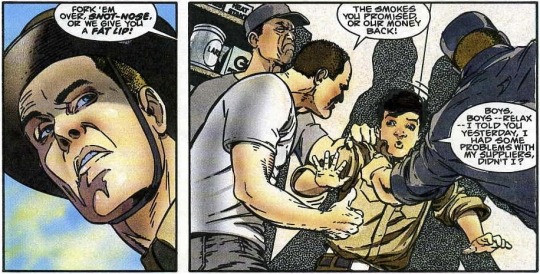
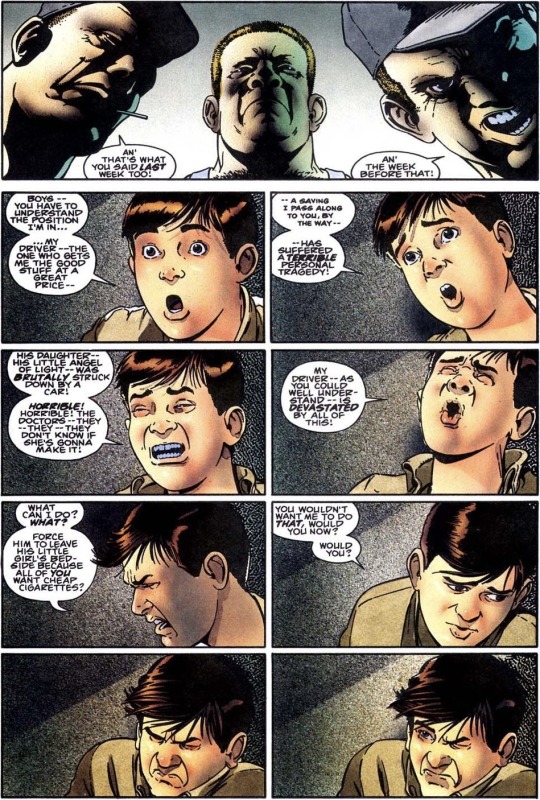
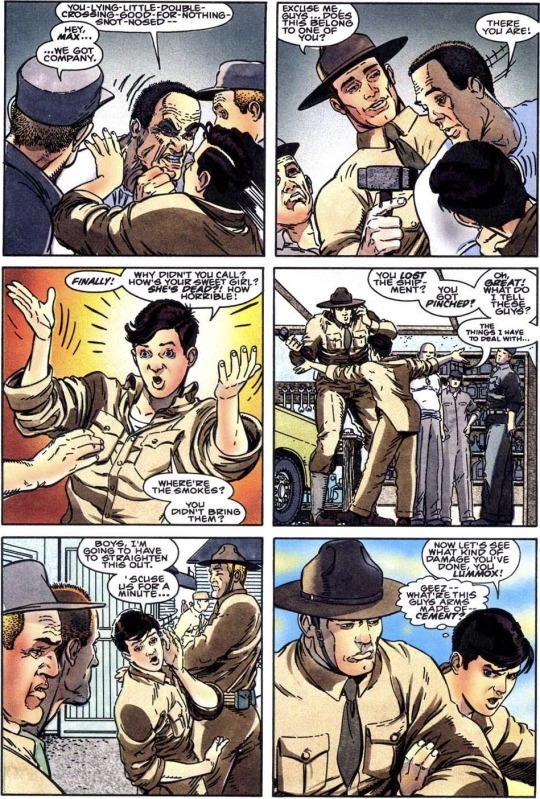
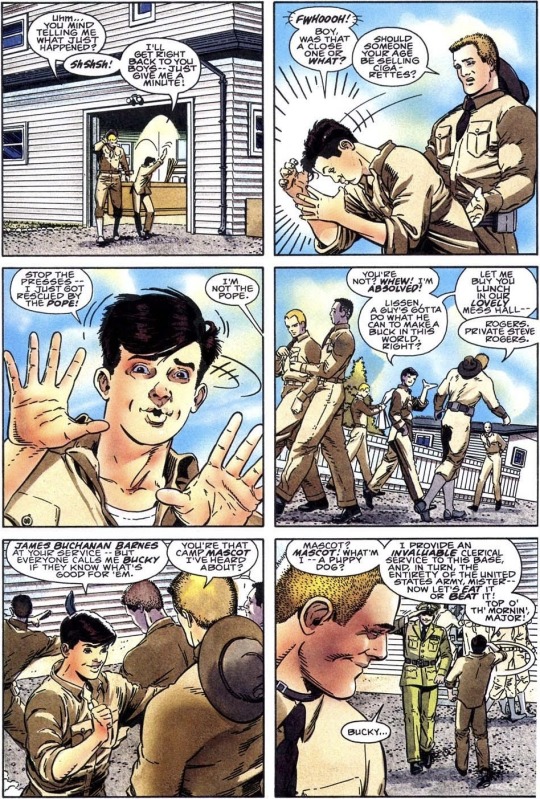
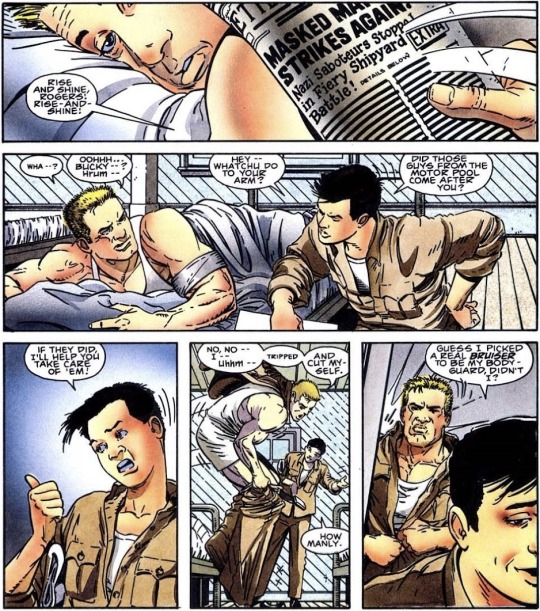
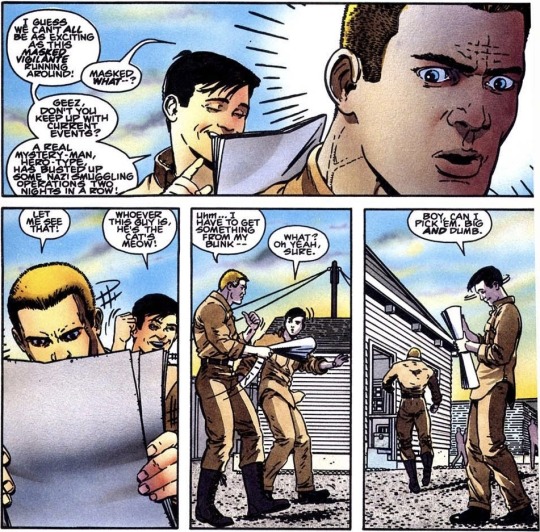
The Adventures of Captain America (1991) #2
#weeee I really enjoyed this#the Golden Age comics completely skipped past Steve and Bucky’s relationship before Bucky learned that Steve was Captain America#by tacking on Bucky becoming Steve’s partner to the end of Steve’s origin story and going from there#I had no idea that Bucky smuggling contraband at Camp Lehigh predated Ed Brubaker’s comics#though I think Brubaker’s Bucky was more well-liked#and to a certain extent his business was known about and tolerated#he trades with a major in one of the Captain America and Bucky (2011) issues#and there's a reference to Bucky's smuggling being covered up so that he wouldn't get in trouble#in one of the flashbacks in Captain America (2005)#his cigarettes and candy bars were all legit to my knowledge#whereas this Bucky is described in the previous issue summary for the next issue as a ‘con man’#and he needs Steve to protect him due to his bad deals#though that Major seems to like him- he’s smiling for Bucky#we see this Bucky manage to get his way where he wasn’t supposed to more but I think Brubaker’s Bucky came across as more charming#anyway Bucky electing Steve as his bodyguard but also saying if he got beat up then ‘I’ll help you take care of ‘em!’ is cute#I like the way he just inserts himself into Steve’s life#marvel#steve rogers#bucky barnes#my posts#comic panels
1 note
·
View note
Link
I see a lot of well-intentioned fans of Wonder Woman worrying that Steve Trevor’s return somehow negates what he did for Diana. I would like to change this conversation, for Wonder Woman, and for many movies where the impossible is part of the appeal.
At the end of Wonder Woman, Steve Trevor flies a plane full of poison into the sky and detonates it, sacrificing himself, after telling Diana that he loves her and he wishes they had more time to be together. The anguish of watching Steve’s plane explode, and the inspiration of his love, helps to propel Diana into wielding her awesome powers in full. She handily beats the bad guy, her uncle Ares.
Steve’s goodbye to Diana and death are well-staged and effectively wrought. It’s emotional and wrenching, and losing the first man that she loved a hundred years ago has followed Diana into the present day. “Thank you for bringing him back to me,” she writes in a candid e-mail to Bruce Wayne, who had sent her the WWI picture of Diana, Steve, and their trusty companions that kicked off Wonder Woman‘s flashback. The watch that Steve gave her, and that Diana has clearly kept as a treasured memento, rests nearby.
Ever since Wonder Woman‘s sequel was confirmed last year and Chris Pine rumored to be involved in some capacity, we’ve talked here about how they’ll bring the beloved character back: is he but a dream within a dream? A clone? A hallucination? Did Steve’s plane somehow get frozen, preserving him as a young man, as superheroic Steves are wont to do? Godly resurrection? Illusions? Aliens?
Whatever it is that brings back some version of Steve Trevor, it’s likely going to be one of the bigger reveals of Wonder Woman 1984, and I’m guessing our guesses will be off. What it does not do is somehow devalue or change what Steve did out of love for Diana and to help save the world in 1917.
Here’s the thing about death as fictional a plot device: it’s the oldest trope in the book. It’s far older than books—death, and heroes trying to defy it and return a loved one from that state, are among the first stories that humans told each other. Onscreen, in big action movies, death is often used cheaply. We’re so used to it happening we don’t blink when a trenchful of people take heavy fire in a movie like Wonder Woman. A narratively well-earned death like Steve Trevor’s makes more of an emotional impact, sure, and it can make for a more resonant movie-going experience. But the idea that Steve should have to stay statically dead in a fantastical film where anything is possible in order to somehow elevate his actions and what they did to Diana is mind-boggling to me.
Here’s the thing about death: in real life, it is one of the worst things that the people left behind will ever experience. Death is cruel, merciless, and it can leave you feeling like there’s an expanding black hole lodged in your chest for many years. For the rest of your life.
Here’s the thing about death if we could reverse it here like we can in fiction: not a goddamn person on planet Earth would lament lost heroism or sacrifice or any other grandiose romantic bullshit we lay on death to try to make sense of it. Your loved one died to save you but now they’re back again? Sorry, Steve, I’m just not feeling it anymore because of all of that squandered heroism, no one would say ever.
The fact of the matter where Wonder Woman is concerned is that Steve Trevor did what he did in 1917 and it was surely one of the worst things that Diana went through. Having Steve return in some capacity 67 years later does not alter that past. Steve’s death also did not make Wonder Woman a hero. Diana was already a hero, and the loss of him served as a catalyst at a dire moment. That’s what losing someone does: it changes you like a chemical reaction. But it does not create or define you.
We go to see movies like Wonder Woman, Avengers, and Star Wars in order to escape into fictional realities where people get to do the impossible and have abilities that we can only dream about. So often, our heroes rise to the occasion because of a poignant loss, because this is an instinct that we can all understand. Iron Man with Yinsen. Batman and his parents. Luke Skywalker and Obi-Wan Kenobi. Obi-Wan Kenobi and Qui-Gon Jinn. Captain America with Dr. Erskine and later Bucky Barnes. Spider-Man and his Uncle Ben.
But giving death the slip and coming back from it is also a huge appeal of comic books and their film incarnations. Incredible powers like the use of the Force and the capacity to appear as a Force ghost are part and parcel of what makes Star Wars tick. We want to witness worlds where death can’t quite hold us.
It used to be a longstanding fan and creator expectation in Marvel Comics that nobody had to “stay” dead except for Uncle Ben and Bucky Barnes. Those deaths were seen as being so essential to the narratives of Peter Parker and Steve Rogers that they could not be retconned or revived.
Then in 2005, comics writer Ed Brubaker and artist Steve Epting brought Bucky back onto the scene as the brainwashed assassin The Winter Soldier. It turned out that Bucky had not died in World War II after all, but was taken by the Russians, given a bionic arm, and reprogrammed to do their bidding for decades.
Bucky’s return from “the dead” is a perfect example of how such an important character’s revival does not negate the impact that his life and loss created in the first place. In fact, if anything, Brubaker created in The Winter Soldier arc the most tragic and brilliant foil possible for Captain America.
What is more difficult than having to face your best friend turned into your enemy? The film version of Winter Soldier is particularly excellent for the same reason. Cap’s agony at having to fight his old friend, and his unrelenting conflict about it and steadfast belief that Bucky was still Bucky beneath the brainwashing, helped make Winter Soldier into one of the most exciting and moving of the Marvel movies. Their continued melodrama and connection have carried through Civil War and Infinity War, and Bucky is a huge fan favorite. It’s hard to imagine where the MCU would have gone without the Winter Soldier storyline as a part of it.
Yet Marvel has also begun to overplay its hand where these tropes are concerned. They’ve been placing all of their chips on grief as the one failsafe to motivate a hero for too long. It worked so effectively for them before as a critical plot device that Infinity War can be read as a culminating series of attempts at impactful permadeaths in order to galvanize our heroes.
As the Russo brothers and Marvel Studios co-president Kevin Feige gleefully tease that some of the characters lost in Infinity War will really stay dead, they’re missing the point of why we love these films. We don’t need characters that we adore to remain dead for their lives to matter, but we’d like it if their deaths meant something when they happen instead of merely serving as a momentary plot beat.
It’s this kind of cheapened take on death-as-heroic-motivation that makes the Russos open Avengers: Infinity War with the horrific genocide of the Asgardians and the brutal deaths of Loki and Heimdall, just so that Thor is feeling sad and mad enough to go on a reckless quest. Do they know Thor at all? He would have done that anyway.
Will Loki or Heimdall ever return? I’d love that. Loki has also come back from death, not once, but twice, because he still had great things to contribute to the MCU narrative. Good characters in fantastical films don’t need to stay dead, but they do need good plotlines. The problem here doesn’t hinge on whether these characters should come back, but whether they should have died so wastefully in the first place. I don’t go into Avengers for gritty genocidal realism. I want to see them do the impossible.
Does Bucky Barnes’ return to the world cancel out who he was before or the value of how he seemingly died fighting alongside Steve Rogers, Steve’s shield in his hand? Hardly. It heightened the emotional impact of both characters in the modern day because of what they shared in the past. Thus it would likely be with a reunited Diana Prince and Steve Trevor.
We cannot know the circumstances of how they will come together again, but their history, and Diana having felt Steve’s loss, makes the relationship all the richer and all the more compelling. Their experiences are something that we will never experience, but we can have the chance to cheat death and live vicariously through them.
Source.
115 notes
·
View notes
Text
Actually that is a FASCINATING story okay so Batman: Under the Hood is the story of a mysterious new criminal using Joker’s old criminal identity of Red Hood muscling in on Gotham’s drug trade who seemingly knows all of Batman’s tricks and is one step ahead of him. At the end he reveals himself to be Jason Todd, trying to purge Gotham more effectively than Batman with murder and “controlling” crime rather than trying to get rid of it, and also wants to force Batman to kill the Joker, which he is appalled that he hasn’t done already. Kid’s got a point.
Captain America: vol. 5 issue 8 - The Winter Soldier is the story of a mysterious Soviet assassin with a metal arm (ostensibly) killing Red Skull and killing some other asshole who i know nothing about Jack somerhinerother also i’m pretty sure it’s revealed in flashback right away that it’s Bucky but Captain America doesn’t realize until he fights him face to face at which point yeah kinda like the movie he regains his memory and becomes a good guy again.
The two stories don’t seem to have much in common but both involve long-dead sidekicks, Bucky had been in the dirt longer than Jason, but there used to be a saying “Nobody stays dead but Bucky, Uncle Ben, and Jason Todd.” Jason had been dead after the 1988 A Death in the Family storyline which for some reason had a fucking Jigsaw Killer gimmick where fans could call in to decide whether he lived or died guess how that went people really hated Jason’s Robin and Bucky had been dead since ffff idk the fucking 60s? Earlier? These were characters famous for being killed off for real.
They were also both beloved iconic sidekicks who died horrible deaths and caused their mentors a ton of y’know guiltguiltguilt mangst w/e i faaaaiilleeedd hiiimm and they both got brought back to life as temporary villains in big comic book arcs at pretty much EXACTLY the same fucking time that’s the weird part it was in 2004-2005 now like the Red Hood story got STARTED first but there’s no way....they were both being worked on at the same time, roughly, so there’s no way someone at Marvel could have plagiarized the idea in time to work it into the Captain America arc if you get what i’m saying so like i just think it’s fascinating these comic writers seem to get strokes of bizarrely specific inspiration at the exact same time
Or, y’know all the execs were all at a party doing cocaine and kicked the idea around and then blacked out and forgot they told each other
1 note
·
View note
Text
some recs
this isnt The reclist, bc i never have the patience to compile it, but have some stuff that is somewhat recent:
The Night War: 60th Anniversary Edition - praximeter (Zimario) - 100k+
Rating: Teen And Up Audiences
Warnings: Creator Chose Not To Use Archive Warnings, No Archive Warnings Apply
Relationships: James “Bucky” Barnes & Steve Rogers, James “Bucky” Barnes/Original Female Character(s) (brief), James “Bucky” Barnes/Steve Rogers
Characters: James “Bucky” Barnes, Rebecca Barnes Proctor, Winifred Barnes, Gabe Jones, Original Male Character(s), Howling Commandos, Steve Rogers, Peggy Carter
Additional Tags: World War II, Historical Accuracy, Diary/Journal, Classic War Memoir, Period Typical Attitudes, Period-Typical Racism, Jewish Character, Bucky Barnes-centric, Bucky Barnes Feels, War, Canon-Typical Violence, Bucky Barnes’s Notebooks, Unreliable Narrator, Writer Bucky Barnes, Pre-Slash, Blink And You Miss It Slash, Slow Burn, Stucky endgame, Internalized Homophobia, Angst, Holocaust
Summary:
In 1947, Master Sergeant James B. Barnes’s surviving field journals were posthumously published as the classic war memoir The Night War. Now a high school history classroom mainstay and required reading at West Point, this highly anticipated 60th Anniversary Edition presents the original, unedited text alongside detailed historical notes that provide important context to the extraordinary wartime heroics of Captain America and the Howling Commandos.
Barnes, James B. The Night War: The Wartime Memoirs of a Howling Commando. Ed. Harold Miller. 60th Anniversary ed. New York: HarperCollins, 2005. Print.
There Is No Shortage of Blood - Dira Sudis (dsudis), alby_mangroves - WIP 50k+
Rating: Explicit
Warnings: Creator Chose Not To Use Archive Warnings
Relationships: James “Bucky” Barnes/Steve Rogers
Characters: James “Bucky” Barnes, Steve Rogers, Original Characters
Additional Tags: Rape Recovery, Rape Aftermath, Rape Fantasy, Flashbacks, Suicidal Thoughts, Self-Harm, unsafe bdsm practices, Bucky’s Broken Dick, Sexual Dysfunction, Established Relationship, Bucky Barnes Recovering, Winter Soldier Trial, Army, Therapy, Catholic Bucky Barnes, Alternate Universe - Canon Divergence, Post-Captain America: The Winter Soldier, Avengers Tower, Bucky Barnes’s Trigger Words, Other Additional Tags to Be Added, Additional Warnings In Author’s Note
Summary:
The long slow recovery of Bucky Barnes after his escape from HYDRA.
(And the longer, slower recovery of his sex life.)
despite the threatening sky and shuddering earth (they remained) - praximeter (Zimario) - WIP 25k+
Rating: Mature
Warnings: Creator Chose Not To Use Archive Warnings, No Archive Warnings Apply
Relationships: James “Bucky” Barnes/Steve Rogers, James “Bucky” Barnes & Steve Rogers
Characters: James “Bucky” Barnes, Steve Rogers, Sam Wilson (Marvel), Tony Stark, Maria Hill, Natasha Romanov (Marvel), Bruce Banner
Additional Tags: Winter Soldier Trauma Warnings, Non-Consensual Body Modification, Body Horror, Body Modification, Touch-Starved, Canon Divergence - Captain America: The Winter Soldier, Captain America: The Winter Soldier AU, The Mask Can’t Come Off, Hurt Bucky Barnes, Bucky Barnes Feels, Non-Consensual Drug Use, Drug Withdrawal, Identity Porn, Identity Reveal, Hurt/Comfort, Art, Embedded Images, art by quietnight, American Sign Language
Summary:
“They really didn’t want the mask to come off.” Hill thumbed through the scans, and pulled out a film that she then handed over to Sam, face mostly expressionless but for the flat line of her pursed lips.
Sam accepted the film and held it up to the light, angling so both he and Steve could see it, squinting at the outline of the Winter Soldier’s skull, and the blips of unnatural white that showed up, God, in his brain, not to mention about half his teeth, plus the mask, with its thin protrusions—
“Those are pins,” Steve realized. He looked over at Hill. “The mask—it’s nailed to his face.”
Hill’s face was as unmoved as ever. “Like I said. They really didn’t want it coming off.”
Who Let You In? - birdbrains - SERIES 76k
Rating: Teen And Up Audiences
Warnings: No Archive Warnings Apply
Relationships: Steve Rogers & Sam Wilson, James "Bucky" Barnes & Sam Wilson, James "Bucky" Barnes/Steve Rogers
Characters: Steve Rogers, Sam Wilson (Marvel), James "Bucky" Barnes
Additional Tags: Up all night to get Bucky, Mental Health Issues, Obedience, Trauma, Consent Issues, Triggers, Sneaky trauma, Food
Series: Part 1 of Eat Rotten Fruit
Summary:
“Is he here?” Sam asked.
“I don’t know,” said Steve. “I’m—hey, Bucky, are you here? Can you hear me?”
“Or whatever you prefer to be called,” Sam put in.
“Yeah,” Steve said. “It’s me, that dumb guy with all the problems? Remember me?”
///
New and "improved."
Closed Book - AggressiveWhenStartled - 38k
Rating: Explicit
Warnings: No Archive Warnings Apply
Relationships: James "Bucky" Barnes/Steve Rogers, Steve Rogers & Tony Stark, James "Bucky" Barnes & Natasha Romanov, James "Bucky" Barnes & Tony Stark, Steve Rogers & Natasha Romanov
Characters: James "Bucky" Barnes, Steve Rogers, Natasha Romanov (Marvel), Tony Stark
Additional Tags: Natasha Is a Good Bro, Amnesia, How many times can Bucky get amnesia, At least one more, This fic is not compliant with anything, Tony Stark has a lot of feelings, Supersoldier sex can break things, A lot of things, Arguing, This was supposed to be stupid Stucky fluff, How did it become a Bucky&Tony comedy hour brofic, what the hell happened, Upside still a lot of Stucky fluff, So I guess it accomplishes both things
Summary:
Bucky woke up with a headache, a mouth that tasted like something had died in it, and hands-down, swear-to-god, the most beautiful man he had ever seen asleep in his lap.
Bucky was also, he realized after a moment, strapped down to a hospital bed with about six different monitors making unsynced, equally piercing, beeps. Beyond that he couldn’t quite see—there was a hideous floral curtain pulled around the bed, and while he could just make out figures moving in the room beyond it, the pattern made his head pound even worse the longer he looked at it.
So. That was concerning.
three white horses - magdaliny - 16k
Rating: Mature
Warnings: Creator Chose Not To Use Archive Warnings
Relationships: James "Bucky" Barnes/Steve Rogers
Characters: Steve Rogers, Sam Wilson (Marvel), James "Bucky" Barnes, Sharon Carter (Marvel)
Additional Tags: Grief/Mourning, Death, Suicide, Jewish Bucky Barnes, Queer Brooklyn, Unreliable Narrator
Summary:
Steve, it's not your fault, Sam had tried to say, before Steve cut him off, and Steve doesn't think that's untrue so much as it's irrelevant; fault's got nothing to do with it. It's just—wrong. It's wrong. Steve couldn't wrap his head around it the first time, how wrong it was. Steve should have gone first. Was supposed to. Bucky could have carried on without Steve, he knows, but Steve without Bucky is a zero sum. There should never be a world that Steve is in and Bucky isn't.
3 notes
·
View notes
Text
Wolverine’s 15 Craziest Retcons
Wolverine is a powerhouse whose claws, super-strong adamantium skeleton and incredible healing factor make him a force of nature. He’s also a messed up guy with a history filled with tragedy, confusion and contradictions. It was established early on that Wolverine suffered from a combination of brain damage, mental trauma, psychic blocks and memory implants that gave him amnesia and flashbacks of things that never happened. That makes him… complicated, to say the least.
RELATED: Everything You Knew is a Lie: 15 Most Altered Superhero Origins
Until Wolverine’s origin was laid out in the pages of the appropriately-named 2001 mini-series “Origin” (by Bill Jemas, Paul Jenkins and Joe Quesada, with art from Andy Kubert and Richard Isanove), his life was a collection of ideas that would get changed whenever a new writer came along. Those changes are known in comics as retroactive continuity or “retcons,” and they can be both interesting and problematic. He’s not the only character with retcons, of course, but he’s one of the most famously affected by them. With Wolverine’s new movie “Logan” making a stir in the ether, the CBR team runs down 15 of Wolverine’s biggest retcons.
HIS HEALING FACTOR
One of Wolverine’s defining powers is his healing factor, which allows him to quickly walk off almost all injuries. It’s part of what makes Wolverine almost indestructible, which is why it’s kind of surprising that he didn’t start out that way.
In his first appearance in Len Wein and Herb Trimpe’s “Incredible Hulk” #181 (1974), Wolverine didn’t heal rapidly at all. Instead, he was so fast that Hulk could barely touch him, except for one moment when Hulk hits Wolverine, but he mysteriously shrugged off the impact. It was only when he became a regular member of the X-Men in 1977’s “X-Men” #107 that his healing was established, but throughout the ’80s, it took him weeks and even months to heal from major injuries. Starting in the 1990s, Wolverine’s healing ramped up until he healed from a nuclear incineration within minutes. He later explained this by saying his healing factor grew more efficient the more he used it, retconning his earlier weakness.
HE KNEW EVERYONE
For a long time, it was said that no one knew how old Wolverine was, because his healing factor made him both immortal and also kept him from showing his age. That meant writers could say he was as old as they wanted him to be, and wrote stories of Wolverine hanging around for decades. With his long life, it makes sense that he met a few familiar faces along the way, but it kind of got out of hand.
For example, in Archie Goodwin and Howard Chaykin’s “Wolverine/Nick Fury: The Scorpio Connection” (1989), Wolverine tells Nick Fury that they knew each other in his days serving with Canadian intelligence. However, “Wolverine Origins” #17 later shows them meeting during World War II. Since Fury didn’t dispute Wolverine in ’89 and didn’t recognize Wolverine, that was clearly a retcon. Also, the story showed him meeting Captain America, even though Cap didn’t recognize him decades later. How can you forget Wolverine? That hairdo alone tends to stick with you.
WEAPON PLUS
One of the defining moments of Wolverine’s life was his kidnapping by the Weapon X program, which forced the powerful adamantium metal onto his bones and tried to brainwash him. But Weapon X itself has gone through a lot of changes throughout the years. In 1975’s “Giant Size X-Men Annual” #1, Wolverine was codenamed Weapon X, but that changed in “Wolverine” #50 (1991), when Weapon X became the name of the super-soldier program that experimented on him.
In Grant Morrison and Frank Quitely’s “New X-Men” #129 (2002), another huge retcon was introduced when it said the “X” in Weapon X stood for the Roman numeral ten, meaning there were other experiments going all the way back to World War II, with more created after Wolverine. The program’s full name became the Weapon Plus program, and included most Marvel super-soldiers (including Captain America) as former members. At that point, it was said that early Weapon Plus experiments involved animals, but “Uncanny X-Force” #22 (2012) retconned Weapon III as the human supervillain, the Skinless Man.
RELATED: Bait and Switch: 15 Comic Book Reveals That Were Changed
HE MET PROFESSOR X
Wolverine became an official member of the X-Men in “Giant Size X-Men Annual” #1 (1975), when Professor X went to the Canadian government to recruit Logan because the original team of X-Men was lost on the mutant island Krakoa. Wolverine reluctantly agreed, which seemed kind of odd, considering he’s always been a lone wolf and didn’t fit in well with the rest of the team.
It was always the first meeting between the two, but that all changed with Daniel Way and Mike Deodato’s “Wolverine Origins” #29 in 2008. In that issue, Professor X revealed that Wolverine had been sent years before their meeting in Canada to kill him. Xavier knew about Wolverine’s mission, but used his psychic powers to erase his memory of the meeting and also implant the suggestion to become an X-Man because Xavier wanted to use Logan as a weapon. This retcon set up Xavier as kind of a jerk, manipulating and lying to Wolverine for decades.
HE FOUGHT THE ANGEL OF DEATH (A LOT)
As we mentioned earlier, Wolverine’s healing factor has grown to pretty ridiculous levels. Even with his unbreakable skeleton and rapid healing, Wolverine seemed to be able to brush off death way too easily, and it got to the point where someone had to explain why. When Marvel decided the time had come to kill off Wolverine, a new explanation for his miraculous healing was retconned.
In Marc Guggenheim and Howard Chaykin’s “Wolverine” story arc in 2008, it was revealed that Wolverine actually had died many times in the past, but each time had fought Lazaer (the Angel of Death) for the right to escape Purgatory and come back to life. As quickly as that was set up, Wolverine discovered his soul had been damaged and made a deal with Lazaer that if it was fixed, he would stay dead. Just in time for the “Death of Wolverine” stories, Logan was killed for good. Or at least, so far…
HIS REAL NAME
The real name of Wolverine has been a huge mystery, which makes sense since he couldn’t even remember where or when he was born. It didn’t help that he spent some time as a secret agent using false names. Over the years, there have been a few suggestions for his name, several of which contradict each other.
In Chris Claremont and John Byrne’s “Uncanny X-Men” #139 (1980), it was first revealed that Wolverine’s name was “Logan,” but he didn’t say if it was his first or last name. This became a critical point, and something other comics played with. Throughout the comics, they’ve also made references to the name “James,” but the matter seemed to be settled in “New X-Men” #143, when a file in the Weapon X program listed his name as “James Logan.” However, in “Wolverine Origins,” it was retconned and finally made canon that his original name was James Howlett. Logan was just the name of the family groundskeeper.
SILVER FOX
It’s hard to overstate how complicated Wolverine’s relationship is with the woman known as Silver Fox, since she’s both one of his greatest loves and greatest mysteries. In fact, she’s arguably been the subject of more retcons and switcheroos than any other character in his history.
First introduced in “Wolverine” #10 (1989), Silver Fox was a former lover who was killed by his archenemy Sabretooth, and her death became the spark that lit the flames of hatred between the two for years. Yet, in “Wolverine” #60-64 (1992), her death was retconned when Wolverine discovered she never died at all, and was actually an agent of HYDRA. In fact, the comics went so far as showing him a fake cabin that was used to implant his false memories of her. Her death was retconned yet again in Brian Michael Bendis and Olivier Coipel’s “House of M” in 2005, when Wolverine recovered memories of Silver Fox being killed by Sabretooth, after all. They didn’t even bother to explain that one.
HIS FATHER
As we mentioned before, Sabretooth is Wolverine’s most cruel and sadistic archenemy, revelling in tormenting Logan. There have been a lot of attempts to explain the conflict between the two, and one went way too far.
Sabretooth was originally created by Chris Claremont and John Byrne in “Iron Fist” #14 (1977), but readers quickly noticed his similarity to Wolverine, so they became enemies. The two fought lots of times, but in “Wolverine” #41 (1991), Sabretooth shocked the comic world by telling Logan they were father and son. It kind of made sense, since the two look similar, have similar powers and Sabretooth is indeterminately older. Later, Claremont in interviews confirmed he intended for Sabretooth to be Wolverine’s father. However, in the very next issue, this was revealed as false by Nick Fury and S.H.I.E.L.D., who conducted DNA testing to prove Sabretooth wasn’t Wolverine’s father, after all. That left their relationship to continue, but the roots of their hatred still hasn’t been solved… at least not the way readers may have wanted.
HE WAS A LUPINE
Now we’re getting into some of the bigger retcons Wolverine has gone through, which were changes to his very species. From his joining the X-Men, it’s been said that he was a mutant, which was how Professor X was able to locate Wolverine. That all changed in “Wolverine” #53 in 2007, though. In that story, Wolverine met a new enemy named Romulus (who we’ll get to later); he explained they were actually not mutants, but a new species of human evolved from canines instead of simians, or what he called Lupines. More than that, he claimed that all other wild mutants like Sasquatch, Sabretooth and Feral were Lupines, and that Sabretooth hated Wolverine because he was from a blond-haired tribe that hated the dark-haired tribe on sight.
That retcon went over with fans about as well as a screen door on Wonder Woman’s invisible airplane, which may be why this was reversed in “Wolverine” #312 (2012), when Romulus’ own sister Remus told him that Lupines didn’t exist, and said Wolverine was a mutant, after all.
ROMULUS
Speaking of Romulus, let’s get to that big ball of retcons. By any standard, Wolverine has had a hard life. He’s been crushed, blown up and poisoned, but his physical injuries are nothing compared to his mental trauma. Pretty much every woman he’s ever loved has been brutally murdered, he’s fought through countless wars, and most of his life has been spent not knowing who he was or where he came from. There was no rhyme or reason to any of that, except to show why he’s such a hard-drinking and angry loner.
That all changed in Jeph Loeb and Simone Bianchi’s “Wolverine” #50 (2007), when Wolverine had dreams of a mysterious figure known as Romulus, who was thousands of years old and had been manipulating Wolverine before he was born. He secretly controlled Weapon X, took Wolverine’s son Daken from his mother’s womb, arranged for the death of Wolverine’s lovers over the years and pretty much got the ball rolling on anything bad that ever happened to Logan. His entire existence is a retcon of Wolverine’s sucky life.
HE STARTED WEAPON X
Since Barry Windsor-Smith’s classic story “Weapon X,” which appeared in “Marvel Comics Presents” #72-84 in 1991, Weapon X has been portrayed as a dark and shadowy organization that kidnapped and subjected Wolverine to the torturous process of bonding adamantium to his skeleton. The moment the Weapon Plus program came into his life changed Logan forever, and certainly wasn’t something he agreed to. At least, that’s the way it always was until 2012’s “Wolverine #312.”
In that story, Wolverine has a climactic fight with Romulus, who reveals that his claims of the Lupine were lies (another retcon mentioned earlier) and that he wants to create a new race of his own. In the final moments, Romulus also says that Wolverine was the one who altered his own memories to make himself into a test subject, and that Weapon X is and always was Wolverine’s idea. So far, that hasn’t been explained, because it makes no sense. It also contradicts the claims and flashbacks of Wolverine and other people involved in Weapon X.
ADAMANTIUM
Besides his claws, Wolverine’s unbreakable skeleton is one of his most defining physical features, with the indestructible metal used to reinforce all his bones, making them unbreakable. His skeleton is one of the strongest objects in the Marvel Universe, second only to Captain America’s shield. Much like everything else involving Wolverine, his adamantium skeleton is also a retcon.
In his first appearance fighting the Hulk, it was never said that Wolverine’s entire skeleton was covered in adamantium, only his claws. Wein only intended the claws themselves to be adamantium, and removable at that. After Logan joined the X-Men, later comics established that the adamantium ran through his entire skeleton. That made him not just fast with a quick healing factor and razor-sharp claws, but unbreakable, leading to his legendary immortality and invulnerability. It’s hard to imagine the old Canuckle-head without his metal skeleton, but that’s exactly what his creators did.
HIS CLAWS
When it comes to Wolverine, his most prominent feature is his pair of razor-sharp adamantium claws. That’s why we’ll be getting into how those claws have changed over the years, and how they’ve been retconned since the very beginning.
In his first fight against Hulk and Wendigo in “Incredible Hulk” #181, Wolverine fought the Hulk with his claws out the entire time, and never retracted them. That implied that his claws were attached to his gloves, which was actually the original writer Len Wein’s intention. When he returned in “Giant Size X-Men Annual” #1, Wolverine could retract his claws, but everyone assumed the claws were attached to his gloves. In “X-Men” #98 (1976), Wolverine surprised everyone when his gloves were removed, and he still was able to pop his claws, showing they were a part of his body, not his gloves. Reportedly, this was changed because Chris Claremont felt it would be easy for anyone to be Wolverine just by putting on his gloves. By having the claws inside his arms, they became a part of him and one of his most distinguishing features.
HIS (BONE) CLAWS
In his early appearances, it was said quite clearly that Wolverine’s claws were added during the process at Weapon X. Wolverine himself said this many times, and Weapon X confirmed it. In Fabian Nicieza and Scott Lobdell’s “X-Men” #25 (1993), Magneto infamously ripped the adamantium out of Wolverine’s skeleton, leaving him a shattered mess. Everyone expected Wolverine’s claws to be torn out as well, since they were (as previously said) believed to be a part of Weapon X.
But in the aftermath, they discovered his claws were actually made of bone, and the adamantium was just covering the claws. This was a huge retcon, since it meant his claws were in fact part of his mutation after all. It also meant his claws had been a part of him all along. This became clarified in “Wolverine Origin” #2, when he was shown as a young boy popping his bone claws for the first time.
HE WAS AN ACTUAL WOLVERINE
This is the big one, the mother of all retcons, so controversial that it never even made it to the printed page. It involves Wolverine’s very nature and existence, and goes all the way back to his first Hulk appearance, where he appeared to fight the Hulk and Wendigo with no explanation of who he was and where he came from. When he returned in the pages of “X-Men,” Xavier said he was a mutant, but that’s not what his creators intended.
Rumor has it that Marvel planned to reveal Wolverine wasn’t a mutant, but an actual wolverine, who had been turned into a human being. The idea was that the High Evolutionary (pictured), a supervillain obsessed with evolving animals, would have created Wolverine, making his mutant history a huge retcon. Wein has loudly stated that the evolved wolverine idea wasn’t his, laying the blame on Chris Claremont, Dave Cockrum or John Byrne. In an interview with Cockrum, he did admit he planned to have the High Evolutionary involved in Wolverine’s origin, which seems like confirmation. Given everything we’ve seen of Wolverine over the years, we’re kind of glad that idea never saw the light of day.
What do you think is Wolverine’s biggest retcon? What other Logan retcons have you noticed?
The post Wolverine’s 15 Craziest Retcons appeared first on CBR.com.
http://ift.tt/2iVrlSu
8 notes
·
View notes